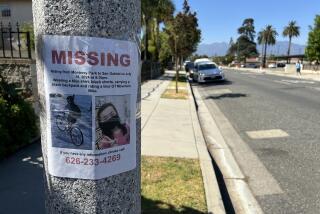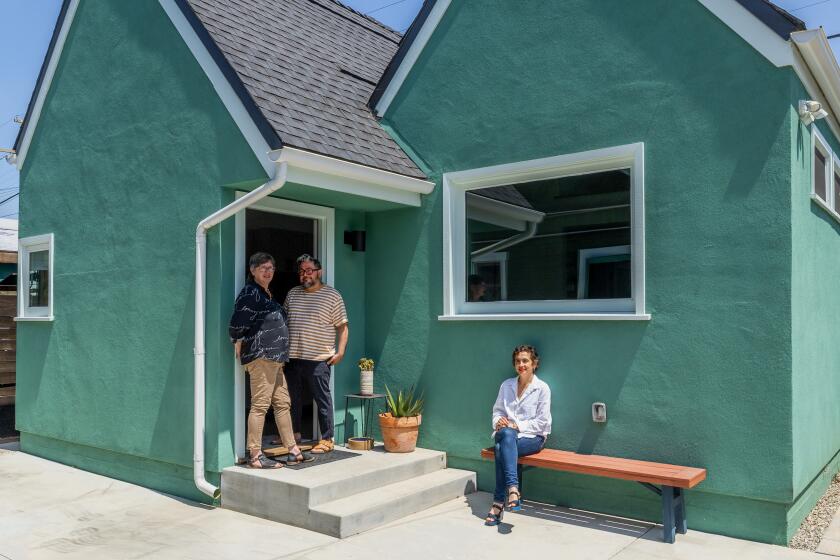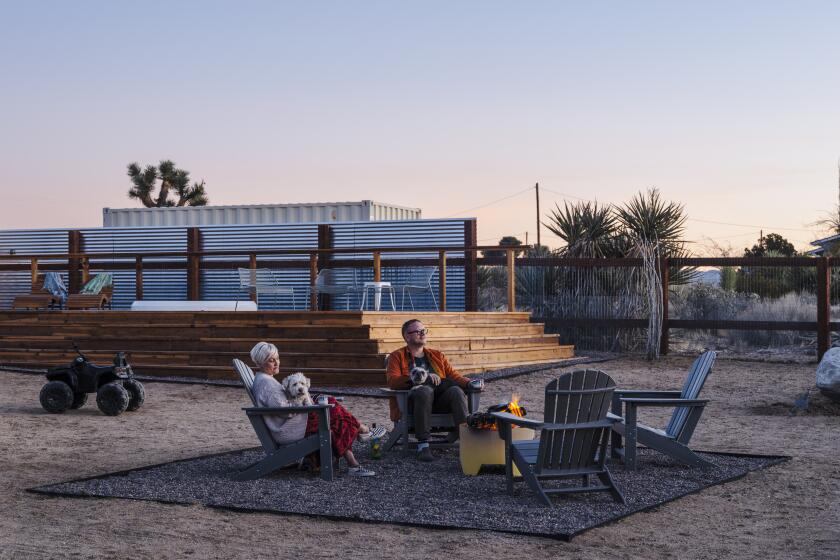Traffic Stoppers : Historic Homes on Path of Freeway Extension Are Jewels to Owners
El Sereno resident Esperanza Esparza always had a feeling there was something historic about her pink-painted house.
Not because of the home’s unusual concrete roof and walls. Or the Egyptian-influenced steps out front, its Mayan-looking outside trim, the Mission Revival touches visible here and there, or its wood-accented Craftsman interior.
It was probably more because of its spiritual nature--or at least that of one of its former owners.
“We’ve heard this house was built for the revivalist preacher Billy Sunday,” Esparza said Saturday afternoon as she sat in the home’s two-story, hall-like living room next to a courtyard where legend has it that “meditation meetings” were held.
Esparza had just learned that her 83-year-old concrete-block residence was one of four in her Los Angeles neighborhood named to the National Register of Historic Places--a designation more commonly associated with tourist attractions than a home for a family of six.
The entire five-block El Sereno neighborhood has been declared a historic district by the U.S. Department of Interior.
That designation, which was welcomed by preservationists, puts another hurdle in the path of the proposed extension of the Long Beach Freeway through the adjoining South Pasadena area. Federal highway officials are required by law to protect historic homes in the path of the freeway.
Sixty-seven of the 86 homes in a turn-of-the-century subdivision known in the early days as the Short Line Villa Tract contributed to the historic district designation, according to federal officials. The homes are in a triangular area bounded by Kendall Avenue on the north, Alpha Street on the west and Berkshire Drive on the southeast.
“The small area contains a fine representative collection of early 20th Century middle-class residential designs, including excellent local examples of Craftsman, bungalow and Spanish Revival architecture,” stated a National Register report.
The neighborhood is also a good example of small-scale subdivisions that were built along early Los Angeles electric trolley lines before World War II, according to experts. After the war, the increasing popularity of the automobile changed the size and scope of new housing developments in the Southland.
Esparza, who has lived in the house since 1989 with her entertainment-industry husband, is its eighth owner. The pair spent months sanding and scraping nine coats of paint off the home’s wood paneling and concrete tile floors when they moved in.
“We’re definitely pleased. I’d hate to see this house get shoveled under,” Esparza said.
The historic designation was hailed Saturday by architectural experts who suggest that the El Sereno neighborhood is a little-known jewel.
“It evokes a simpler, more civil time in Southern California as expressed in its down-home architecture and sense of community,” said Sam Hall Kaplan, an urban critic and author of “L.A. Lost and Found.”
Michael Burch, a USC architecture professor who lives in nearby South Pasadena, said the old Short Line Villa Tract has largely avoided the “haphazard development” that has smothered similar small subdivisions from that era.
Those living along Berkshire Drive, where three of the historic homes adjoin one another, seemed just as thrilled.
“So many of the houses you see around here are works of art,” said Bob Towner--a professional artist who draws storyboards for television commercials. His family has lived for a decade in a 50-year-old clapboard house across the street from the historic homes.
“Look around Los Angeles and you see a sea of stucco,” Towner said. “Not here--this neighborhood is an architectural treasure, a diamond in the rough.”
Towner expressed sympathy for highway officials such as Ron Kosinski who were jolted by the neighborhood’s designation. Kosinski, Caltrans’ chief environmental planner in Los Angeles, said he is “shocked and dismayed” by it.
Said Towner: “I feel sorry for some of the transportation engineers. Some of them started their careers 30 years ago designing this. They’re ready to retire now and it still isn’t built.”
A few houses down the street, neighbor Francis Price said she supports the 710 Freeway. The route’s completion will make travel more convenient, she said, and it can be designed and built in an aesthetically pleasing manner.
But if the historic designation “brings the property values up around here, I think it’s wonderful,” Price said.
A more neutral position on the freeway issue was staked out by Eleanor Ives. She is a medical doctor who has lived in one of the four designated historically significant homes since 1944.
Built in 1904, Ives’ brown wood-shingled house is cited as “a well-preserved representation of ‘arroyo culture’ architecture’ ” in the federal report. It has always been “very comfortable” to live in, Ives said.
“But I don’t worry about the freeway. I won’t be around if they build it--I’m going to be 89 on Wednesday.”
More to Read
Sign up for Essential California
The most important California stories and recommendations in your inbox every morning.
You may occasionally receive promotional content from the Los Angeles Times.







